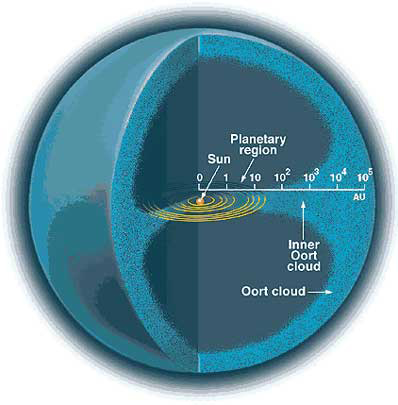Giant Stealth Planet May Explain Rain of Comets from Solar System's Edge

Our sun may have a companion that disturbs comets from the edge of the solar system — a giant planet with up to four times the mass of Jupiter, researchers suggest.
A NASA space telescope launched last year may soon detect such a stealth companion to our sun, if it actually exists, in the distant icy realm of the comet-birthing Oort cloud, which surrounds our solar system with billions of icy objects.
The potential jumbo Jupiter would likely be a world so frigid it is difficult to spot, researchers said. It could be found up to 30,000 astronomical units from the sun. One AU is the distance between the Earth and the sun, about 93 million miles (150 million km).
Most systems with stars like our sun — so-called class G stars — possess companions. Only one-third are single-star systems like our solar system.
Not a nemesis
Scientists have already proposed that a hidden star, which they call "Nemesis," might lurk a light-year or so away from our sun. They suggest that during its orbit, this red dwarf or brown dwarf star would regularly enter the Oort cloud, jostling the orbits of many comets there and causing some to fall toward Earth. That would provide an explanation for what seems to be a cycle of mass extinctions here.
Still, other astronomers recently found that if Nemesis did exist, its orbit could not be nearly as stable as claimed.
Breaking space news, the latest updates on rocket launches, skywatching events and more!
Now researchers point to evidence that our sun might have a different sort of companion.
To avoid confusion with the Nemesis model, astrophysicists John Matese and Daniel Whitmire at the University of Louisiana at Lafayette dub their conjectured object "Tyche" — the good sister of the goddess Nemesis in Greek mythology, and a name proposed by scientists working on NASA's Wide-Field Infrared Survey Explorer (WISE) space telescope.
It is the WISE observatory that, using its all-seeing infrared eye, stands the best chance of having spotted Tyche, if this companion to the sun exists at all, the researchers said. [WISE telescope's amazing images]
Matese and Whitmire detailed their research Nov. 17 online edition of the journal Icarus.
Comet-flinging sun companion
The researchers noted that most comets that fly into the inner solar system seem to come from the outer region of the Oort cloud. Their calculations suggest the gravitational influence of a planet one to four times the mass of Jupiter in this area might be responsible.
Two centuries of observations have indicated an anomaly that suggests the existence of Tyche, Matese said. "The probability that it could be caused by a statistical fluke has remained very small," he added.
The pull of Tyche might also explain why the dwarf planet Sedna has such an unusually elongated orbit, the researchers added.
If Tyche existed, it would probably be very cold, roughly minus 100 degrees F (-73 degrees C), they said, which could explain why it has escaped detection for so long — its coldness means that it would not radiate any heat scientists could easily spot, and its distance from any star means it would not reflect much light.
"Most planetary scientists would not be surprised if the largest undiscovered companion was Neptune-sized or smaller, but a Jupiter-mass object would be a surprise," Matese told SPACE.com. "If the conjecture is indeed true, the important implications would relate to how it got there — touching on the early solar environment — and how it might have affected the subsequent distributions of comets and, to a lesser extent, the known planets."
Is Tyche really out there?
The fact of Tyche's existence is questionable, since the pattern seen in the outer Oort cloud is not seen in the inner Oort.
"Conventional wisdom says that the patterns should tend to correlate, and they don't," Matese said.
If the WISE team was lucky, it caught evidence for the Tyche solar companion twice before the space observatory's original mission ended in October. That could be enough to corroborate the object's existence within a few months as researchers analyze WISE's data.
But if WISE detected signs of Tyche only once (or not at all), researchers would have to wait years for other telescopes to confirm or deny the potential solar companion's existence, Matese said.

Charles Q. Choi is a contributing writer for Space.com and Live Science. He covers all things human origins and astronomy as well as physics, animals and general science topics. Charles has a Master of Arts degree from the University of Missouri-Columbia, School of Journalism and a Bachelor of Arts degree from the University of South Florida. Charles has visited every continent on Earth, drinking rancid yak butter tea in Lhasa, snorkeling with sea lions in the Galapagos and even climbing an iceberg in Antarctica. Visit him at http://www.sciwriter.us
